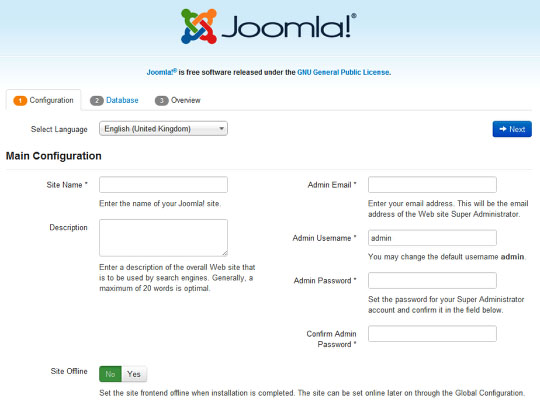
In this tutorial, we will show you how to install Joomla on CentOS 8. For those of you who didn’t know, Joomla is a free, open-source, and popular content management system (CMS) that can be used to build online applications and websites. It uses a PHP application and back-end databases such as MySQL or MariaDB. Joomla can be used for small business and corporate websites, e-commerce stores, online magazines, personal blogs and portfolios, and much more.
This article assumes you have at least basic knowledge of Linux, know how to use the shell, and most importantly, you host your site on your own VPS. The installation is quite simple and assumes you are running in the root account, if not you may need to add ‘sudo‘ to the commands to get root privileges. I will show you the step-by-step installation of Joomla on a CentOS 8 server.
Prerequisites
- A server running one of the following operating systems: CentOS 8.
- It’s recommended that you use a fresh OS install to prevent any potential issues.
- A
non-root sudo useror access to theroot user. We recommend acting as anon-root sudo user, however, as you can harm your system if you’re not careful when acting as the root.
Install Joomla on CentOS 8
Step 1. First of all, make sure that all packages are up to date.
sudo dnf update
Step 2. Installing LAMP Stack.
If you don’t have a LAMP stack already installed on your server, you can follow our guide here. Also, install required PHP modules, run the command below to install other required PHP extensions for Joomla:
sudo dnf install php-{spl,hash,ctype,json,mbstring,zip,gd,curl,xml,common}
Step 3. Installing Joomla on CentOS 8.
Now, we download the latest version of Joomla:
wget https://downloads.joomla.org/cms/joomla3/3-9-14/Joomla_3-9-14-Stable-Full_Package.zip?format=zip -O joomla.zip unzip Joomla_3-9-14-Stable-Full_Package.zip -d /var/www/html/
Give proper permissions to the webroot directory with the following command:
sudo chown -R apache:apache /var/www/html/ sudo chmod -R 775 /var/www/html/
Step 4. Configuring MariaDB for Joomla.
By default, MariaDB is not hardened. You can secure MariaDB using the mysql_secure_installation script. You should read and below each step carefully which will set a root password, remove anonymous users, disallow remote root login, and remove the test database and access to secure MariaDB.
mysql_secure_installation
Configure it like this:
- Set root password? [Y/n] y - Remove anonymous users? [Y/n] y - Disallow root login remotely? [Y/n] y - Remove test database and access to it? [Y/n] y - Reload privilege tables now? [Y/n] y
Next, we will need to log in to the MariaDB console and create a database for the Joomla. Run the following command:
mysql -u root -p
This will prompt you for a password, so enter your MariaDB root password and hit Enter. Once you are logged in to your database server you need to create a database for Joomla installation:
MariaDB [(none)]> CREATE DATABASE joomla; MariaDB [(none)]> GRANT ALL PRIVILEGES ON joomla.* TO 'joomla'@'localhost' IDENTIFIED BY 'your_strong_password'; MariaDB [(none)]> flush privileges; MariaDB [(none)]> exit;
Step 5. Configuring Apache web server for Joomla.
We will create an Apache virtual host for your Joomla website. First, create ‘/etc/httpd/conf.d/vhosts.conf’ file with using a text editor of your choice:
nano /etc/httpd/conf.d/vhosts.conf IncludeOptional vhosts.d/*.conf
Next, create the virtual host:
mkdir /etc/httpd/vhosts.d/ nano /etc/httpd/vhosts.d/yourdomain.com.conf
Add the following lines:
<VirtualHost YOUR_SERVER_IP:80> ServerAdmin webmaster@yourdomain.com DocumentRoot "/var/www/html/" ServerName yourdomain.com ServerAlias www.yourdomain.com ErrorLog "/var/log/httpd/yourdomain.com-error_log" CustomLog "/var/log/httpd/yourdomain.com-access_log" combined <Directory "/var/www/html/"> DirectoryIndex index.html index.php Options FollowSymLinks AllowOverride All Require all granted </Directory> </VirtualHost>
Save and close the file. Restart the Apache service for the changes to take effect:
systemctl restart httpd.service systemctl enable httpd.service
Step 6. Configure Firewall.
In case of OS firewall enabled on your server then provide access to ports 80 and 443 to be accessed from outside the network:
sudo firewall-cmd --permanent --add-service=http sudo firewall-cmd --permanent --add-service=https sudo firewall-cmd --reload
Step 7. Accessing the Joomla Installer.
Open your web browser and type the URL: http://your-server-ip, you should see the following page:

Congratulations! You have successfully installed Joomla. Thanks for using this tutorial for installing the Joomla content management system on CentOS 8 system. For additional help or useful information, we recommend you to check the official Joomla website.